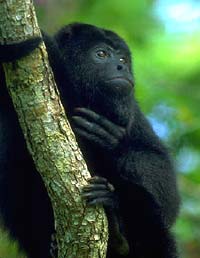Primates trade smell for sight

Conventional wisdom says that people deficient in one sense–such as vision or hearing–often acquire heightened acuity in another. These adjustments, of course, take place over the lifetime of an individual. Now it appears, however, that similar adjustments may occur over evolutionary time. Yoav Gilad and his colleagues at the Max Planck Institute for Evolutionary Anthology in Germany and the Weizmann Institute in Israel have found a correlation between the loss of olfactory receptor (OR) genes, which are the molecular basis for the sense of smell, and the acquisition of full trichromatic color vision in primates.
While humans, nonhuman primates, and mice have roughly the same number of OR genes, in humans a high percentage (60%) of these are nonfunctional so-called “pseudogenes”, as compared to nonhuman apes which have about 30% pseudogenes, and the mouse which has about 20%. Reliance on the sense of smell, it appears, decreases for animals that develop a dependence on other senses, such as hearing or sight, to survive. In characterizing this high proportion of pseudogenes, Yoav Gilad et al. asked: Is this characteristic of all primates? If not, at what point in primate evolution did the increase occur? Looking at 19 primate species including humans, the team found that Old World monkeys had roughly the same percentage of OR pseudogenes as nonhuman apes, but a much higher percentage than New World monkeys–except for one, the howler monkey. The percentage of OR pseudogenes in the howler monkey was much closer to that seen in the Old World monkeys and apes than in its New World cousins. The sense of smell, it appears, deteriorated independently both in the ape and Old World monkey lineage as well as in the howler monkey lineage. Although Old World monkeys, apes, and the howler monkeys do not share an exclusive common ancestor, they do share another sensory feature: trichromatic color vision.
In trichromatic color vision, three retinal protein pigments, called opsins, absorb various wavelengths of light, which the brain processes to produce full-color images. Apes and Old World monkeys carry three opsin genes, and most New World monkeys carry only two, though females can sometimes have three. Only howler monkeys routinely have three genes occurring in both sexes. Thus, full trichromatic vision evolved twice in primates–once in the common ancestor of apes and Old World monkeys, about 23 million years ago, and once in the howler monkey lineage, about 7 – 16 million years ago. The evolution of color vision, the authors propose, coincided with a growing complement of OR pseudogenes and a deterioration of the sense of smell. Gilad et al. suggest that investigating the types of visual cues required for finding food may shed light on the nature of this connection.
All works published in PLoS Biology are open access. Everything is immediately available without cost to anyone, anywhere–to read, download, redistribute, include in databases, and otherwise use–subject only to the condition that the original authorship is properly attributed. Copyright is retained by the author. The Public Library of Science uses the Creative Commons Attribution License.
CONTACT:
Svante Paabo
Max Planck Institute for Evolutionary Anthropology
Leipzig, 04103
Germany
ph: 49-341-3550-501
paabo@eva.mpg.de
Media Contact
All latest news from the category: Life Sciences and Chemistry
Articles and reports from the Life Sciences and chemistry area deal with applied and basic research into modern biology, chemistry and human medicine.
Valuable information can be found on a range of life sciences fields including bacteriology, biochemistry, bionics, bioinformatics, biophysics, biotechnology, genetics, geobotany, human biology, marine biology, microbiology, molecular biology, cellular biology, zoology, bioinorganic chemistry, microchemistry and environmental chemistry.
Newest articles

Silicon Carbide Innovation Alliance to drive industrial-scale semiconductor work
Known for its ability to withstand extreme environments and high voltages, silicon carbide (SiC) is a semiconducting material made up of silicon and carbon atoms arranged into crystals that is…

New SPECT/CT technique shows impressive biomarker identification
…offers increased access for prostate cancer patients. A novel SPECT/CT acquisition method can accurately detect radiopharmaceutical biodistribution in a convenient manner for prostate cancer patients, opening the door for more…

How 3D printers can give robots a soft touch
Soft skin coverings and touch sensors have emerged as a promising feature for robots that are both safer and more intuitive for human interaction, but they are expensive and difficult…





















